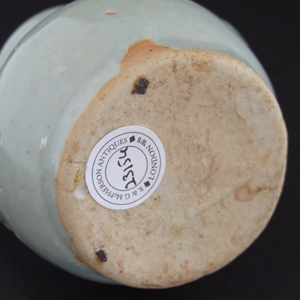
YUAN 1279 – 1368 Qingbai Porcelain
A Yuan Qingbai Porcelain Double Gourd Shaped Ewer and Cover. Yuan Dynasty, Probably Jingdezhen Kilns, Jiangxi Province, c.1300-1340. The Handle in the Form of an Elongated Dragon. The Hand Modelled Dragon is Crisply Rendered and the Whole Ewer has a Good bright Clear Glaze of a Pale Green Blue.
SOLD
- Condition
- Very good, a minute glaze frit to the end of the spout c.1 x 1 mm.
- Size
- Height : 13 cm (5 inches)
- Provenance
- The collection of S. R. Parker Esq (President of the Southeast Asian Ceramics Society 1978-1980).
- Stock number
- 23154
- References
- Qingbai porcelain ewers of this form were recovered from the Sinan wreck dated to c.1323. See : Cultural Relics found off Sinan Coast (Various authors, National Museum of Korea 1977) plate 334. For a similar Yuan Qingbai ewer attributed to the Jingdezhen kilns See : Chinese and South East Asian White Ware found in the Philippines (Oriental Ceramic Society of the Philippines, Oxford University Press, 1993. ISBN 0-19-588615-1) page 99, plate 85. For another Yuan Qingbai ewer of this form See : Jingdezhen Wares, The Yuan Evolution, Catalogue of an Exhibition Presented by The Oriental Ceramic Society of Hong Kong and the Fung Ping Shan Museum, University of Hong Kong 23 March to 31 May 1984 (The Oriental Ceramic Society of Hong Kong,1984.) page 105, plate 51. For a further Qingbai ewer and cover of this type see `Sold Items` stock number 19332 and another 22472.
Information
Qingbai Ware :
The earliest known qingbai wares were produced in Jingdezhen in Jiangxi province around the late 10th century and are characterized by faint pale-blue glazes on low, wide forms. Qingbai continued to be enormously popular and highly produced throughout the Song dynasty (960-1279) and was prevalent in the Yuan dynasty (1279-1368), but slackened during the Ming dynasty (1368-1644) until being replaced by tianbai, ‘sweet white’ ware. The initial forms of qingbai were simple bowls and dishes, but by the mid-Northern Song the forms had advanced to include a wide variety of objects used for daily life such as ewers, boxes, incense burners, granary models, vases, jars, sculptures, cups, cupstands, water droppers, lamps, grave wares, and tools for writing and painting. The precedent for the majority of these forms is found in earlier metalwork and lacquer and Rawson has suggested that the imitation of silver was the primary force behind the production of white wares, including qingbai. See our `History` section for more information about Song Porcelain and Stoneware by Mindy M. McDonald.





